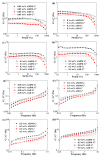Fracturing Fluid Polymer Thickener with Superior Temperature, Salt and Shear Resistance Properties from the Synergistic Effect of Double-Tail Hydrophobic Monomer and Nonionic Polymerizable Surfactant
- PMID: 37446764
- PMCID: PMC10343922
- DOI: 10.3390/molecules28135104
Fracturing Fluid Polymer Thickener with Superior Temperature, Salt and Shear Resistance Properties from the Synergistic Effect of Double-Tail Hydrophobic Monomer and Nonionic Polymerizable Surfactant
Abstract
To develop high-salinity, high-temperature reservoirs, two hydrophobically associating polymers as fracturing fluid thickener were respectively synthesized through aqueous solution polymerization with acrylamide (AM), acrylic acid (AA), 2-acrylamido-2-methylpropanesulfonic acid (AMPS), nonionic polymerizable surfactant (NPS) and double-tail hydrophobic monomer (DHM). The thickener ASDM (AM/AA/AMPS/NPS/DHM) and thickener ASD (AM/AA/AMPS/DHM) were compared in terms of properties of water dissolution, thickening ability, rheological behavior and sand-carrying. The results showed that ASDM could be quickly diluted in water within 6 min, 66.7% less than that of ASD. ASDM exhibited salt-thickening performance, and the apparent viscosity of 0.5 wt% ASDM reached 175.9 mPa·s in 100,000 mg/L brine, 100.6% higher than that of ASD. The viscosity of 0.5 wt% ASDM was 85.9 mPa·s after shearing for 120 min at 120 °C and at 170 s-1, 46.6% higher than that of ASD. ASDM exhibited better performance in thickening ability, viscoelasticity, shear recovery, thixotropy and sand-carrying than ASD. The synergistic effect of hydrophobic association and linear entanglement greatly enhancing the performance of ASDM and the compactness of the spatial network structure of the ASDM was enhanced. In general, ASDM exhibited great potential for application in extreme environmental conditions with high salt and high temperatures.
Keywords: fracturing fluid polymer thickener; high-salinity and high-temperature; hydrophobic association; linear entanglement; synergistic effect.
Conflict of interest statement
The authors declare no conflict of interest.
Figures














References
-
- Wu G., Chen S., Meng X., Wang L., Sun X., Wang M., Sun H., Zhang H., Qin J., Zhu D. Development of antifreeze fracturing fluid systems for tight petroleum reservoir stimulations. Energy Fuels. 2021;35:12119–12131. doi: 10.1021/acs.energyfuels.1c01819. - DOI
-
- Zhu D., Wang Z., Liu Y., Zhang H., Qin J., Zhao Q., Wang G., Shi C., Su Z. Carbon nanofiber-enhanced HPAM/PEI gels for conformance control in petroleum reservoirs with high temperatures. Energy Fuels. 2022;36:12606–12616. doi: 10.1021/acs.energyfuels.2c02866. - DOI
-
- Kotb A., Almubarak T., Nasr-El-Din H.A. Surfactant and friction reducer interaction in high salinity slickwater fracturing; In Proceeding of the SPE International Hydraulic Fracturing Technology Conference and Exhibition; Muscat, Oman. 11 January 2022.
-
- Da Q.A., Yao C.J., Zhang X., Wang X.P., Qu X.H., Lei G.L. Investigation on microscopic invasion characteristics and retention mechanism of fracturing fluid in fractured porous media. Pet. Sci. 2022;19:1745–1756. doi: 10.1016/j.petsci.2022.03.009. - DOI
MeSH terms
Substances
Grants and funding
LinkOut - more resources
Full Text Sources

